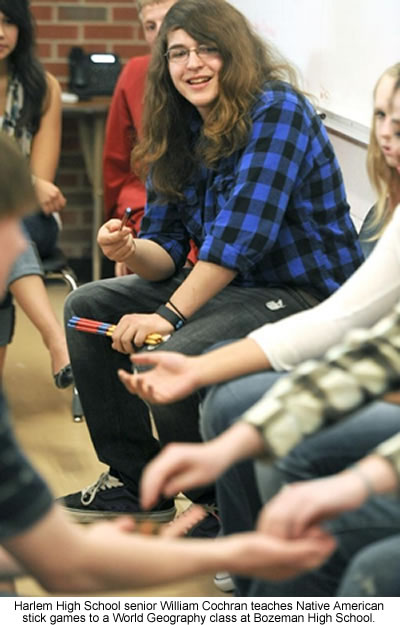 |
Canku Ota
|
 |
|
(Many Paths)
|
||
|
An Online Newsletter
Celebrating Native America
|
||
|
May
1, 2011 - Volume 9 Number 5
|
||
|
|
||
|
Exchange Students
–
Bozeman and Reservation Teens Learn From Each Other |
||
|
by Gail Schontzler Bozeman
Daily Chronicle
|
||
|
credits: Erik Petersen
- Bozeman Chronicle
|
 Bozeman
students have traveled as far as Europe and the Galapagos Islands
to learn about the larger world, but this school year one group of
students didn't have to leave Montana to broaden their understanding
of other people and cultures. Bozeman
students have traveled as far as Europe and the Galapagos Islands
to learn about the larger world, but this school year one group of
students didn't have to leave Montana to broaden their understanding
of other people and cultures.
Twenty Bozeman high school and middle school students traveled last fall to the Fort Belknap Reservation and Harlem High School, where about 90 percent of students are Native American and the senior class is about 40 students, or one 10th the size of Bozeman High's. This week the exchange continued, when about 20 Harlem High students came to visit Bozeman for two days. They shadowed Bozeman students to their classes, visited the Museum of the Rockies and checked out Montana State University. Robin Arnold, Bozeman schools grants coordinator, said the exchange was paid for by a grant of about $40,000 from the state Office of Public Instruction. The exchange is part of Indian Education for All, the state's constitutionally mandated effort to teach all Montana students about Native American history and heritage. "I don't think we get exposed to cultures as much as we should," Chloe Nostrant, 16, a sophomore at Bozeman High, said Wednesday. "We're almost -" "Isolated," said sophomore Peter Obermeyer, 15, finishing Nostrant's sentence. "It's been valuable just to learn about another culture. ...We learned what life on the reservation is like." The main thing she learned from visiting Fort Belknap, Nostrant said, was "how welcoming they were. We felt at home instantly. They were very nice and the food was really good." She especially liked the juneberry soup. RaeLynn Rider, 18, a Harlem High senior and member of the Assiniboine and Gros Ventre tribes, said she sees lots of differences between Bozeman and Fort Belknap. Bozeman is more fast-paced, a bigger town with more people and more things to do, Rider said. At home, if teens want to go to the movies, they have to drive 50 miles to Havre. A shopping trip might mean a drive to Billings or Great Falls. If they want to go out to eat, there are only three or four places to choose from. Still, Rider said she likes Harlem High, where it's easier to get one-on-one mentoring from teachers. "I like the closeness of a smaller school -- around here, you're more like a number," Rider said. At Harlem High, she said, "The teachers know you, they know your family. Most of us are related or grew up together, from kindergarten to high school." Jara Gray, 18, a Harlem High senior and Gros Ventre, said one concern tribal members have is that their native language is dying out, so the school teaches native language as an elective. Native students said they have to contend with stereotypes people have about Indians. Rider said drinking and gambling are the biggest stereotypes. If she goes outside Montana, she said, people think they live in tepees and wear buckskin dresses and moccasins. They're surprised Indians use cell phones. As part of the exchange, the Harlem students taught Bozeman students how to play a traditional Indian stick game. It's like a guessing game, said William Cochran, 18, a senior and member of the Gros Ventre tribe. He said he wants to attend MSU and study to become a doctor. Rider and Gray said they want to attend tribal colleges and study nursing. The students defied stereotypes when it came to their musical tastes. Cochran said he likes everything from Katy Perry to Johnny Cash. Jara said she likes Michael Jackson and George Strait. Obermeyer's tastes include Elton John and modern bands, and Nostrant likes Train. "We like the same music," Rider said, "and we like our pow-wow jams. It's the best of both worlds." |
|
|
||
|
|
||
| Canku Ota is a free Newsletter celebrating Native America, its traditions and accomplishments . We do not provide subscriber or visitor names to anyone. Some articles presented in Canku Ota may contain copyright material. We have received appropriate permissions for republishing any articles. Material appearing here is distributed without profit or monetary gain to those who have expressed an interest. This is in accordance with Title 17 U.S.C. Section 107. | ||
|
Canku Ota is a copyright ©
2000, 2001, 2002, 2003, 2004, 2005, 2006, 2007, 2008, 2009, 2010,
2011 of Vicki Barry and Paul Barry.
|
||
 |
 |
|
|
The "Canku
Ota - A Newsletter Celebrating Native America" web site and
its design is the
|
||
|
Copyright ©
1999, 2000, 2001, 2002, 2003, 2004, 2005,
2006, 2007, 2008, 2009, 2010, 2011
of Paul C. Barry.
|
||
|
All Rights Reserved.
|
||